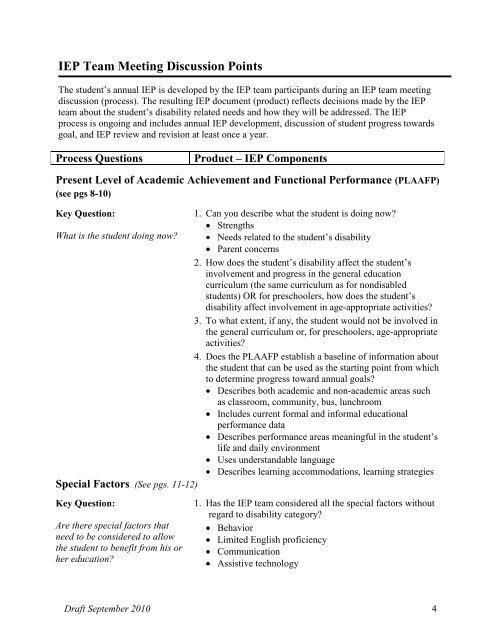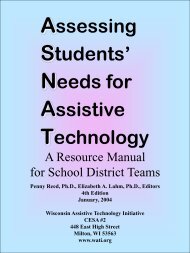Guide for Writing IEPs - The Special Education Team - Wisconsin.gov
Guide for Writing IEPs - The Special Education Team - Wisconsin.gov
Guide for Writing IEPs - The Special Education Team - Wisconsin.gov
Create successful ePaper yourself
Turn your PDF publications into a flip-book with our unique Google optimized e-Paper software.
IEP <strong>Team</strong> Meeting Discussion Points<br />
<strong>The</strong> student’s annual IEP is developed by the IEP team participants during an IEP team meeting<br />
discussion (process). <strong>The</strong> resulting IEP document (product) reflects decisions made by the IEP<br />
team about the student’s disability related needs and how they will be addressed. <strong>The</strong> IEP<br />
process is ongoing and includes annual IEP development, discussion of student progress towards<br />
goal, and IEP review and revision at least once a year.<br />
Process Questions Product – IEP Components<br />
Present Level of Academic Achievement and Functional Per<strong>for</strong>mance (PLAAFP)<br />
(see pgs 8-10)<br />
Key Question:<br />
1. Can you describe what the student is doing now?<br />
• Strengths<br />
What is the student doing now? • Needs related to the student’s disability<br />
• Parent concerns<br />
2. How does the student’s disability affect the student’s<br />
involvement and progress in the general education<br />
curriculum (the same curriculum as <strong>for</strong> nondisabled<br />
students) OR <strong>for</strong> preschoolers, how does the student’s<br />
disability affect involvement in age-appropriate activities?<br />
3. To what extent, if any, the student would not be involved in<br />
the general curriculum or, <strong>for</strong> preschoolers, age-appropriate<br />
activities?<br />
4. Does the PLAAFP establish a baseline of in<strong>for</strong>mation about<br />
the student that can be used as the starting point from which<br />
to determine progress toward annual goals?<br />
• Describes both academic and non-academic areas such<br />
as classroom, community, bus, lunchroom<br />
• Includes current <strong>for</strong>mal and in<strong>for</strong>mal educational<br />
per<strong>for</strong>mance data<br />
• Describes per<strong>for</strong>mance areas meaningful in the student’s<br />
life and daily environment<br />
• Uses understandable language<br />
• Describes learning accommodations, learning strategies<br />
<strong>Special</strong> Factors (See pgs. 11-12)<br />
Key Question:<br />
Are there special factors that<br />
need to be considered to allow<br />
the student to benefit from his or<br />
her education?<br />
1. Has the IEP team considered all the special factors without<br />
regard to disability category?<br />
• Behavior<br />
• Limited English proficiency<br />
• Communication<br />
• Assistive technology<br />
Draft September 2010 4











